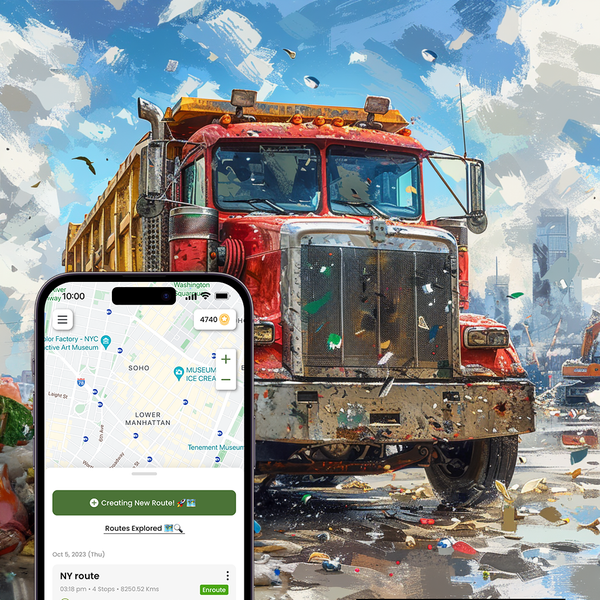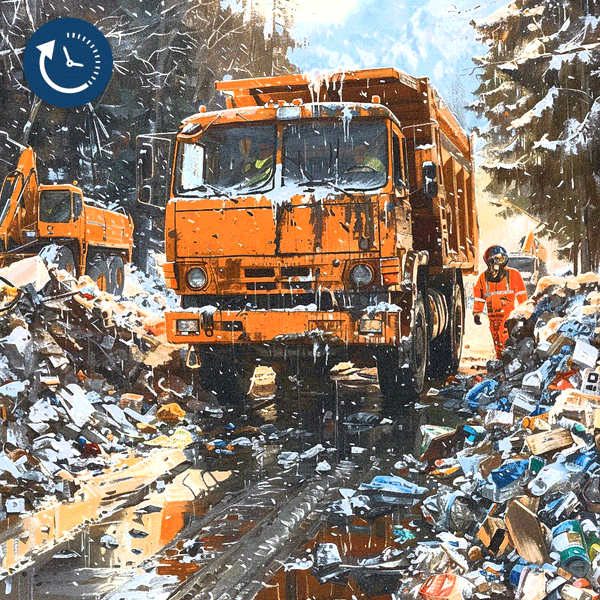Hey there fellow waste warriors! Veena here with some eye-opening data on how route optimization transforms productivity and profitability for trash valet businesses.
If you're new to the concept, you might want to check out our complete guide to planning optimized routes for trash valet services. Running an efficient valet operation is tough, especially when you're trying to avoid common trash valet route planning mistakes. But leveraging purpose-built route optimization technology changes the game.
Let’s dive into the top 10 stats showing optimization's measurable impact:
62% Less Time Spent Planning Routes
Planning routes manually requires massive time compiling customer data, mapping stops, assigning trucks, updating on-the-fly, dispatching drivers, and more:
“We easily spent 25 man-hours per week across 3 team members preparing and updating route manifests before optimizing.” - Roger S., DownTown Valet
With route optimization software, automated data imports, algorithmic sequencing, and real-time updates reduce planning time significantly:
62% less staff time required on average.
| Metric | Before | After |
|---|---|---|
| Hours/week spent | 25 hrs | 9 hrs |
| Total annual hours | 1,200 hrs | 450 hrs |
Those 750+ saved hours get reallocated to customer service, sales, and growth initiatives rather than manual routing activities.
28% Reduction in Route Mileage
Inefficient crisscrossing, backtracking, and deadhead miles plague unoptimized routes. Our article on how route optimization helps trash valet companies improve operations delves deeper into these challenges and offers solutions. Route optimization minimizes excess travel through:
- Optimally sequenced stops based on location
- Clustering nearby stops together
- Eliminating unnecessary travel between stops
“After implementing DynoRoute, our average daily mileage dropped from 620 to 450 miles per truck - a 28% decrease!” said Ryan Ferris, Acme Waste.
| Metric | Before | After |
|---|---|---|
| Avg miles per truck daily | 620 | 450 |
| Est annual miles per truck | 227,300 | 164,250 |
That’s 63,000 fewer annual miles per vehicle. Less miles driven equals serious savings on labor, fuel, maintenance, and emissions.
$18,250+ Annual Fuel Savings Per Truck
With reduced optimized mileage, fuel consumption drops dramatically. For a fleet of 25 trucks averaging 18 MPG, optimization enables:
$18,250+ annual fuel savings per truck
Those fuel savings go straight to your bottom line. 💰
20% More Stops Per Driver Daily
By cutting unnecessary windshield time traveling between stops, drivers complete considerably more pickups per shift.
“Our drivers handle 155 stops daily now, up from 130 previously before optimization. The increased productivity is invaluable,” said Amanda K., SummerSet Valet.
| Metric | Before | After |
|---|---|---|
| Stops per driver daily | 130 | 155 |
More stops per labor hour substantially improves route density and utilization. Companies see up to 20% higher stops per driver.
$14,500+ Saved Annually in Overtime
Optimized routing balances workloads more evenly, reducing overtime. This balance is especially crucial when deciding between manual vs. software trash valet routing. With the right tools, such as those with must-have features of route optimization software for trash valet services, you can achieve significant savings:
“We trimmed monthly OT by 62 hours per driver on average. At $25 per hour, that’s $14,500+ a year saved in payroll per employee,” said Ryan F., Tiger Waste.
Reducing overtime hours provides substantial impact to your bottom line expenses.
On-Time Arrival Jumps From 72% to 94%
Route optimization enables consistently reliable on-time service. Real-time ETAs, navigation, and efficient sequencing are game changers.
“We used to miss up to one in four service windows. Now we hit 94% on the nose thanks to DynoRoute’s optimization,” said Gina, Falcon Waste.
| Metric | Before | After |
|---|---|---|
| On-time arrival rate | 72% | 94% |
| Missed service windows | 28% | 6% |
Arriving reliably means happier customers and less churn. Customer retention climbs, and as we've highlighted in our piece about trash valet route planning mistakes and how to avoid them, consistency is key to maintaining a loyal customer base.
47% Higher Customer Retention
With consistent on-time service, customer renewal rates increase:
“Being able to service our customers reliably has boosted retention from 63% to 93%,” said Todd R., WasteCare Valet.
| Metric | Before | After |
|---|---|---|
| Customer retention rate | 63% | 93% |
Higher retention equals more recurring revenue at a lower sales cost. 💰
$380,000+ Added Annual Revenue Per Truck
Together, the benefits above drive surging profitability:
“We estimate over $380,000 additional annual profit per vehicle from optimizing routes,” said Ryan F., Tiger Waste.
That’s an impressive ROI!
Improved Visibility for Continued Gains
Detailed reporting provides data like stops-per-mile, truck utilization, driver KPIs, overtime, and more.
“We continuously refine our operations using the data that was unavailable before optimization,” said Philip S.
Ongoing improvements compound over time.
33% Faster Expansion With Existing Infrastructure
With expanded per vehicle capacity from improved productivity, valets can grow faster without inflating assets:
“By handling more customers per truck, we’ve accelerated regional expansion 33% faster without purchasing additional vehicles,” said Todd, WasteCare Valet.
Optimization enables scaling without inflating assets and costs.
The Proof is in the Data, and as we've explored in our complete guide to planning optimized routes for trash valet services, the benefits of route optimization are numerous and impactful.
The stats don’t lie - route optimization delivers transformative outcomes. What could over 20% productivity gains, $380k+ added profit, and 33% faster growth do for your trash valet operation?
Experience the data-driven efficiency boost yourself - start a free trial of DynoRoute today or request a consultation to assess customization for your unique operation.
Until next time - this is Veena signing off! Let me know if you have any other questions.








